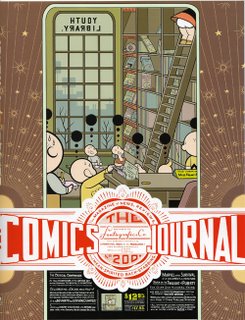[no. 004] Area / pg. 380- 383/ Chris Ware

First of all, the book Area, published by Phaidon, is a very big book that is filled with lots of interesting design work. Chris Ware, from Chicago, has some visually appealing work in this book. Chris is actually a comic artist who “obsesses over unrepentantly luscious forms.” His illustrations are very geometric in form and cartoon-like in color. What particularly appeals to me is his use of space and scale. He utilizes the entire page to paint a well-designed canvas of lines, shapes, and typography. Especially in his “The Comics Journal” poster, the artwork, which we are able to discern without much effort, is very two-dimensional. However, the manner in which he places the typography over the drawn figures, with the smaller type below, makes this piece be perceived as if there is more than just one plane in space that each element is resting on. Not only that, but in the margins of the poster,
 there are very simple, yet eye-catching series of lines and circles that recede towards the title of the piece, moving our interest around the page from drawn figures to type to lines again.
there are very simple, yet eye-catching series of lines and circles that recede towards the title of the piece, moving our interest around the page from drawn figures to type to lines again.In Ware’s “Building Story” and “Branford the Bee” comic strips, he makes use of scale to change up the expected squares of identical size that are typically used in comics. This method makes the comics seem more diagrammatic and dynamic than most other comic strips. In his “Building Story” strip, I like how the diagram like elements, like the connecting lines, close-ups, and icons relate to its content of building and breaking down a certain process.
There is a certain quality to “The Acme Novelty Library” cover that reminds me of a record album cover. I think it is the radial shape that is created with the circles placed on a central axis point that first establishes this. But moreover, it is the compass-like crossbars, dial-like tick marks, roulette table compartments, and generally circular forms that emphasize this too. As a contrast to the colorful, complex center art, the margins of the cover are very simplified and monochromatic.

I like how Chris Ware is very aware of how he is using the spacial elements in his works, contrasting styles within the same piece to create visual interest. There are multiple levels to read into his work that make it something you have to look at closer and closer, pulling you into his comic world.







